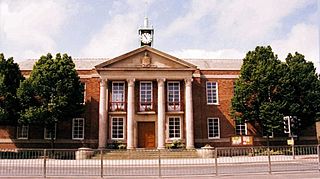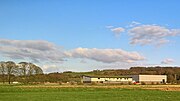
Baron Shuttleworth, of Gawthorpe in the County Palatine of Lancaster, is a title in the Peerage of the United Kingdom. It was created on 15 July 1902 for the Liberal politician Sir Ughtred Kay-Shuttleworth, 2nd Baronet. Both his sons were killed in the First World War and he was therefore succeeded by his grandson, the second Baron. However, both he and his brother, the third Baron, were killed in action during the Second World War. On the death of the third Baron in 1942 the titles passed to his first cousin, the fourth Baron, who survived the Second World War although he was badly wounded. As of 2017 the titles are held by the latter's son, the fifth Baron, who succeeded in 1975. He has been Lord Lieutenant of Lancashire since 1997.

Padiham is a market town and civil parish on the River Calder, in the Borough of Burnley in Lancashire, England. It is located north west of Burnley, and north east of the towns of Clayton le Moors and Great Harwood. It is edged by the foothills of Pendle Hill to the north-west and north-east. The United Kingdom Census 2011 gave a parish population of 10,098, estimated in 2019 at 10,138.

Ightenhill is a civil parish in the Borough of Burnley in Lancashire, England, with a population of 1,975.

Shuttleworth College, formerly Gawthorpe High School, is a mixed 11–16 foundation secondary school located in Padiham, Lancashire, England.

Abbeystead House is a large country house to the east of the village of Abbeystead, Lancashire, England, some 12 km south-east of Lancaster. It is recorded in the National Heritage List for England as a designated Grade II listed building.

Hapton is a village and civil parish in the Borough of Burnley in Lancashire, England, 3 miles (4.8 km) west of Burnley, with a railway station on the East Lancashire Line. At the United Kingdom Census 2011, it had a population of 1,979.
This is a list of Grade I listed buildings in Lancashire, England.
Read Hall and Park is a manor house with ornamental grounds of about 450 acres (180 ha) in Whalley Road, Read, a few miles west of Padiham, Lancashire, England.

Shuttleworth Hall is a 17th-century manor house in the civil parish of Hapton in Lancashire, England. It is protected as a Grade I listed building.

Leck Hall is an 18th-century country house located at Leck, Lancashire, England, near Kirkby Lonsdale.

Forcett Hall is an English country house in the village of Forcett, North Yorkshire, England, some 6.5 miles (10 km) west of Darlington. It is a Grade I listed building.
Briercliffe is a civil parish in the borough of Burnley, Lancashire, England. The parish contains 21 buildings that are recorded in the National Heritage List for England as designated listed buildings. Of these, one is listed at Grade I, the highest of the three grades, two at Grade II*, the middle grade, and the others are at Grade II, the lowest grade.
Hapton is a civil parish in the borough of Burnley, Lancashire, England. The parish contains seven buildings that are recorded in the National Heritage List for England as designated listed buildings. Of these, one is listed at Grade I, the highest of the three grades, one at Grade II*, the middle grade, and the others are at Grade II, the lowest grade. Apart from the village of Hapton, and some industrial encroachment from Burnley to the northeast the parish is rural. Three of the listed buildings are or have been farmhouses. The most notable building in the parish is Shuttleworth Hall; this together with associated structures, is listed. The Leeds and Liverpool Canal passes through the parish, and two of the bridges crossing it are listed.
Ightenhill is a civil parish in the borough of Burnley, Lancashire, England. The parish contains 15 buildings that are recorded in the National Heritage List for England as designated listed buildings. Of these, two are listed at Grade I, the highest of the three grades, and the others are at Grade II, the lowest grade. The parish is partly rural, and partly residential as a district of the town of Burnley. The most notable buildings in the parish are Gawthorpe Hall and its Great Barn. These are both listed, as are structures associated with them. The other listed buildings include a farmhouse dating from the 16th century, a former schoolmaster's house, a parish church and its churchyard wall, a drinking fountain, and two boundary stones.
Padiham is a town and a civil parish in the borough of Burnley, Lancashire, England. The parish contains 29 buildings that are recorded in the National Heritage List for England as designated listed buildings. Of these, two are listed at Grade II*, the middle grade, and the others are at Grade II, the lowest grade. The parish consists of the town of Padiham and surrounding countryside.
Euxton is a civil parish in the Borough of Chorley, Lancashire, England. The parish contains 28 buildings that are recorded in the National Heritage List for England as designated listed buildings. Of these, two are listed at Grade II*, the middle grade, and the others are at Grade II, the lowest grade. The parish contains the village of Euxton, and is surrounded by agricultural land. Many of the listed buildings are, or originated as, farmhouses and farm buildings. The other listed buildings include churches and associated structures, large houses, some with associated structures, and a pair of former weavers' cottages,
Whittington is a civil parish in Lancaster, Lancashire, England. It contains 39 buildings that are recorded in the National Heritage List for England as designated listed buildings. Of these, three are at Grade II*, the middle grade, and the others are at Grade II, the lowest grade. The parish contains the villages of Whittington, Docker and Newton, and is otherwise rural. Most of the listed buildings are country houses with associated structures, smaller houses, and farm buildings. The other listed buildings include a church with a sundial in the churchyard, buildings on a model farm, three milestones, a boundary stone, and a former school.
Samlesbury is a civil parish in the South Ribble district of Lancashire, England. It contains 22 listed buildings that are recorded in the National Heritage List for England. Of these, two are listed at Grade I, the highest of the three grades, and the others are at Grade II, the lowest grade. The parish is mainly rural, and many of its listed buildings are houses, farmhouses and farm buildings. The most important buildings are Samlesbury Hall and the parish church, both of which are listed at Grade I. The other listed buildings include structures associated with the church, a school, a bridge, a church built in the 19th century, and a lodge to the hall.

Padiham Town Hall is a municipal building in Burnley Road, Padiham, Lancashire, England. The town hall, which was the headquarters of Padiham Urban District Council, is a grade II listed building. It is the meeting place of Padiham Town Council.

The Hon. Rachel Beatrice Kay-Shuttleworth MBE (1886–1967) was an English embroiderer, lace-maker, textile collector, teacher and philanthropist. Her textile collection is held at Gawthorpe Hall in Burnley, Lancashire, her family home.














